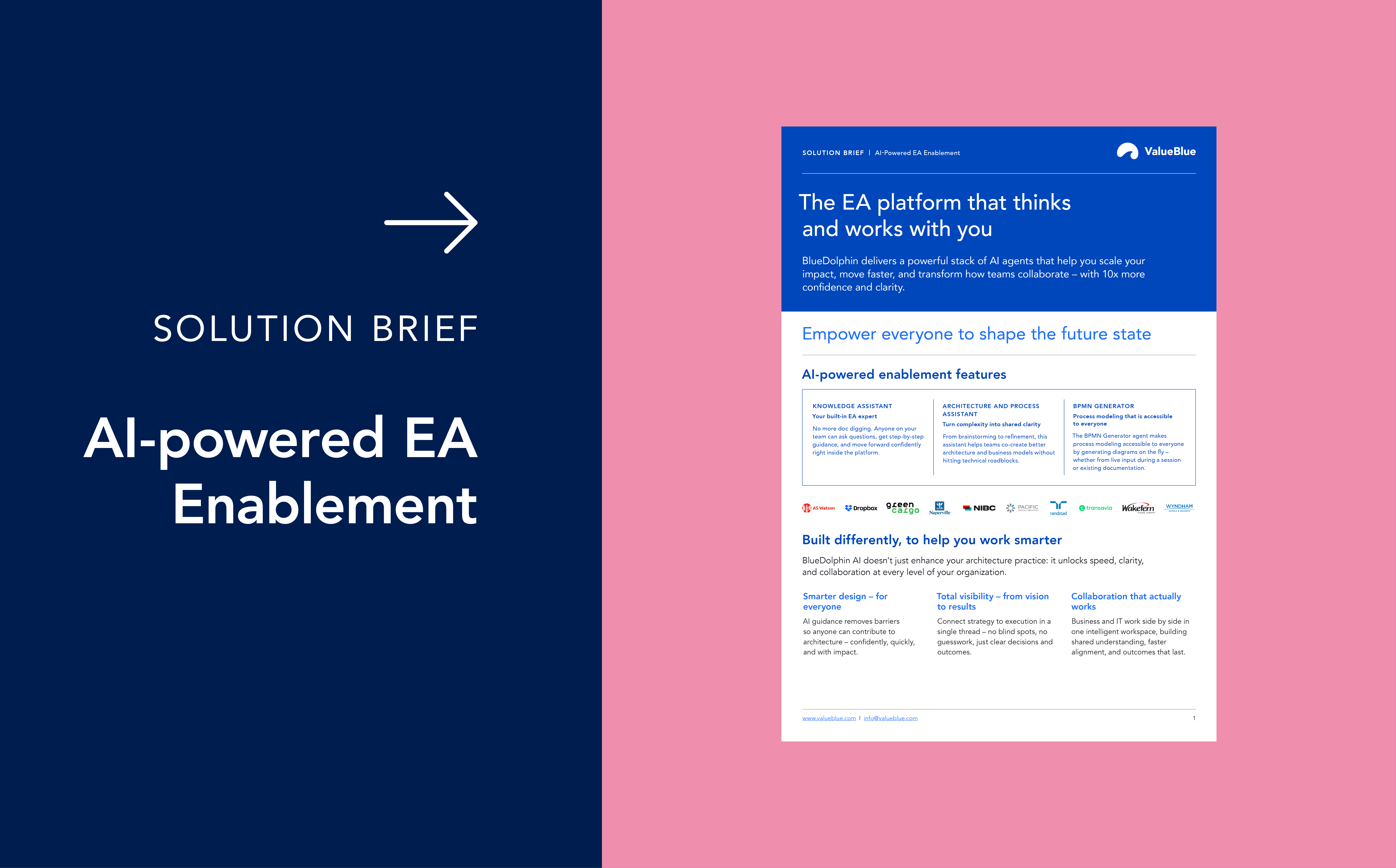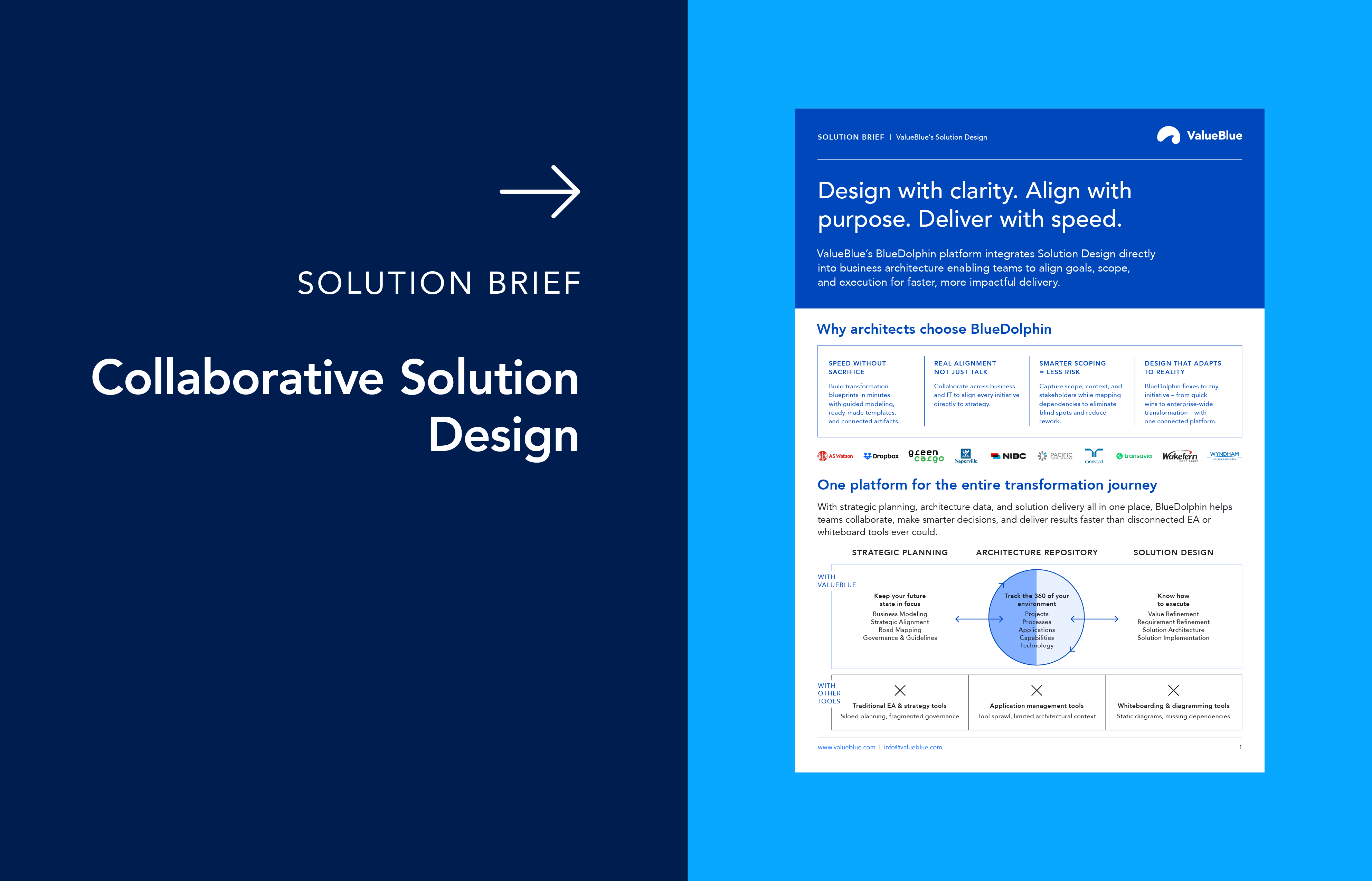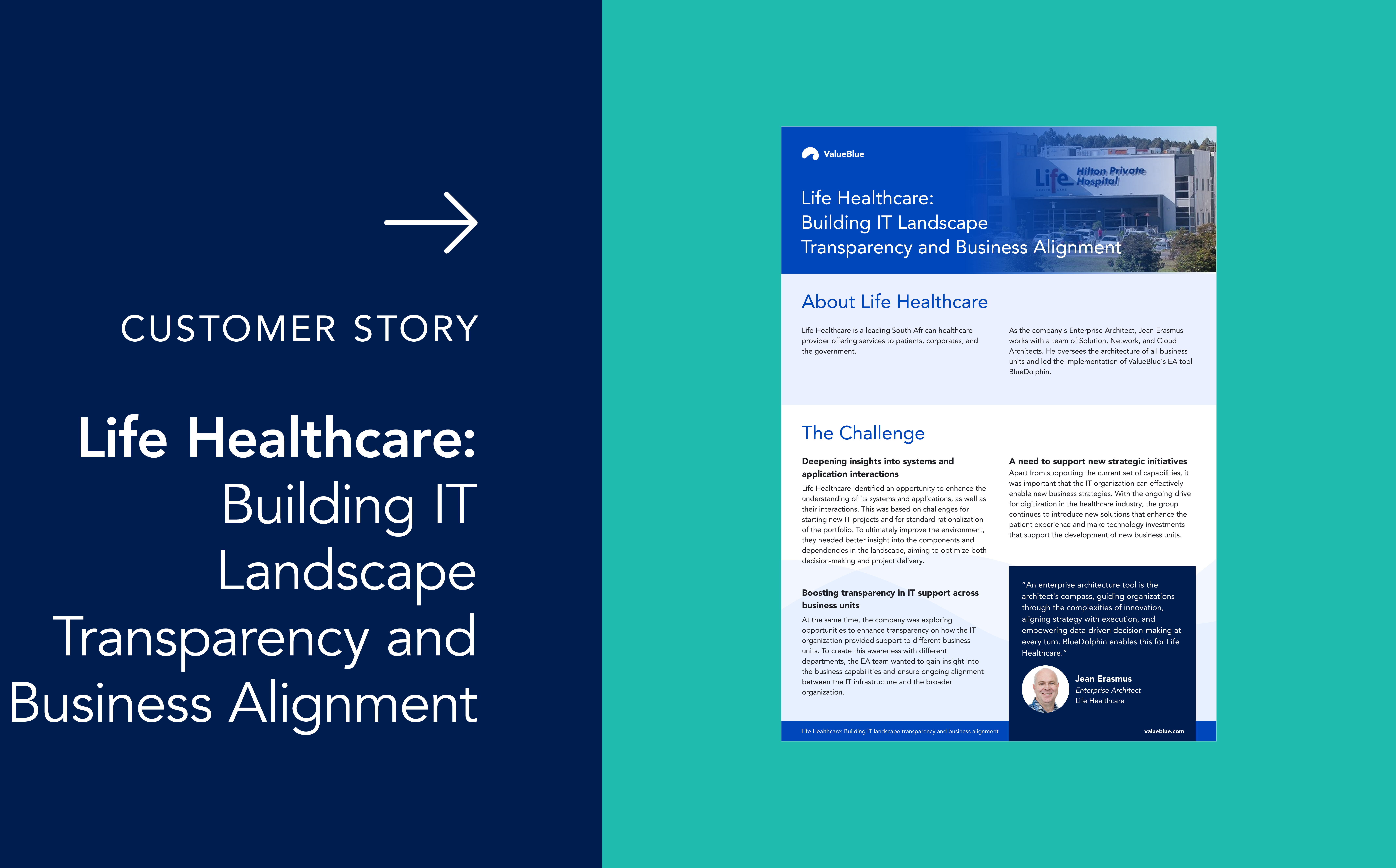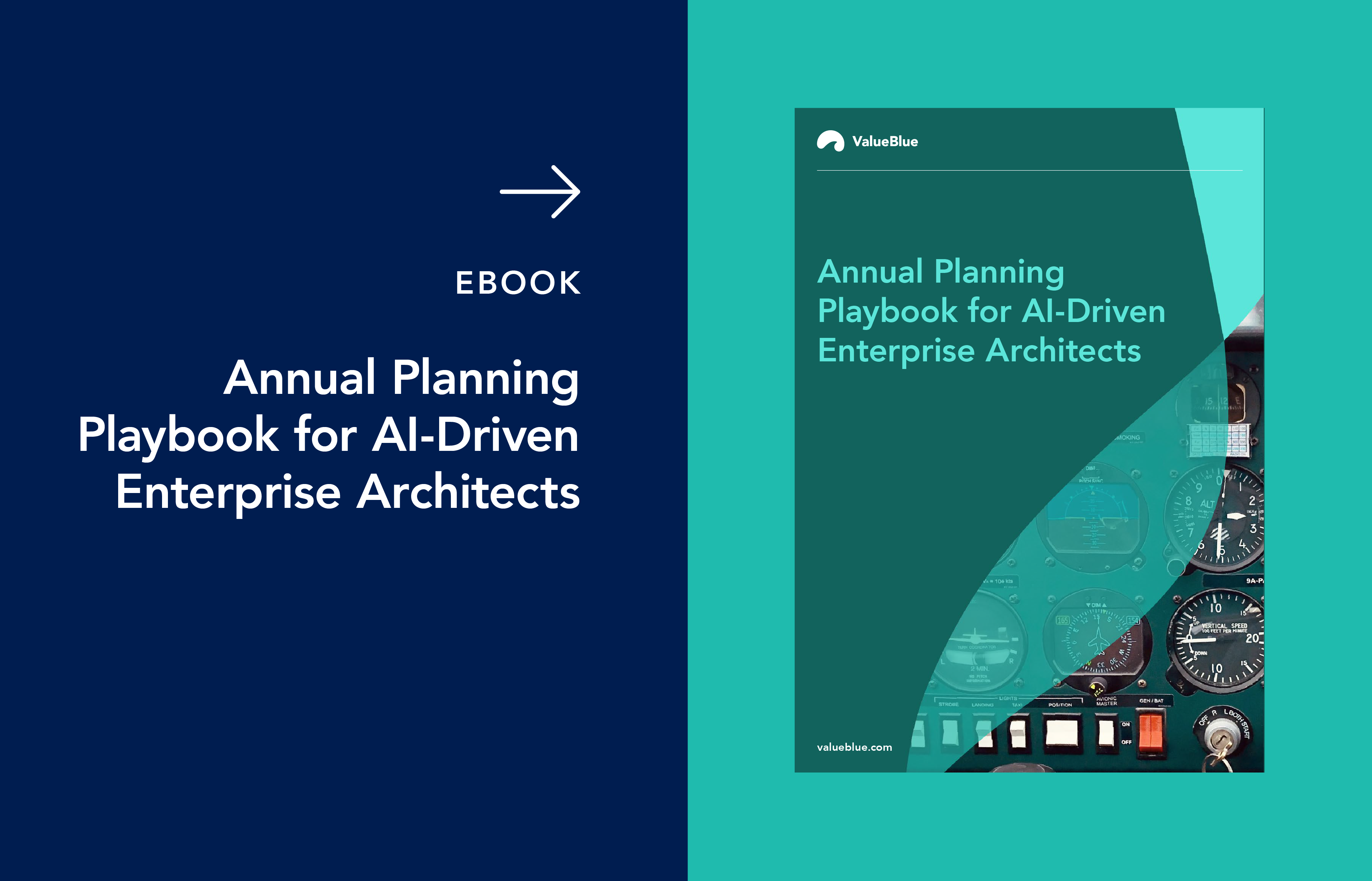Enterprise Architecture Trends: 2023 and Beyond
Last month we hosted a webinar about how Enterprise Architecture has evolved and which Enterprise Architecture trends we expect to have an impact in 2023. Co-presenters Jelle Visser, CCO of ValueBlue, and Diederik Postma, Global Director of Solution Consulting, cover four main topics as it relates to the evolution of this discipline:
• Adaptability as a determining factor for the success of a company
• The fading line between business and IT, as EA moves into the business
• EA as the facilitator for business change
• The future of EA being data-driven and powered by machine learning
Using these four points as a basis, the webinar touches on how your organization should view EA and its role in the upcoming years.
The New Enterprise Architecture 2023
These first three Enterprise architecture trends have been bubbling up for quite a while, and it may not be a surprise that we predicted them at all. The need for adaptability rose sharply during the pandemic and has remained a high priority ever since. The rise of low-code/no-code apps has been moving technical roles into individual departments for some time now. As any Enterprise Architect knows, EA should facilitate business change. However, bringing all these trends together cohesively remains a struggle for many businesses.
Adaptability Determines the Success of a Company
The global COVID-19 pandemic made many companies adapt how they did business at lightning speed. Some companies were able to adapt, and others perished. While we no longer see the daily effects of the pandemic, the agile and adaptive mindset has remained high priority.
Part of the need for adaptability stems from the rapid creation of new businesses focused on the latest technology and trends. Another piece is existing companies will successfully utilize new technology or trends and if you don’t, you risk falling behind. As an enterprise architect, you must identify these opportunities and present them to your organization; EA sets the foundation for an organization to adapt to its rapidly changing environment.
Future EA will determine a company’s success in achieving its organizational goals. However, it is more valuable for Enterprise Architects to focus on “white space” within the organization. That is to say, areas where leaders lack specific support and are often overlooked or ill-equipped to respond to. These gaps allow EAs to surface emerging threats and opportunities to business leaders and recommend strategic responses. Together, EAs and business leaders can accomplish things they cannot do alone.
EA as Part of the Business
Ten years ago, IT departments would decide on all new technology a company purchased. Fast forward to today, and purchasing power has shifted from solely within the IT department to individual departments choosing their own tech stack. This shift is partly due to the rise of SaaS technology and low-code/no-code solutions. Modern companies often opt out of having a traditional IT team in lieu of business technologists existing within each department. While a benefit is each department gets the tools they want when they need them, the lack of communication between departments leads to tech sprawl and often overlapping application functionalities.
Thus, the ever-increasing need for Enterprise Architecture to move into the business. EA takes decentralized systems and applications and governs them from a central, collaborative hub, giving visibility into how they fit together and what this means for the organization overall.
Facilitating Business Change
Adaptability and visibility are two difficult challenges, but in 2023 EA needs to be the backbone helping organizations facilitate them. Let’s connect the idea of Enterprise Architecture as the foundation for organizational change.
The ability to adapt comes from having a clear understanding of where you are, where you want to go, and what is needed to get there. It’s easy to say the greater handle an architect has on their current state the better you can map the road to your future state. However, it’s more difficult to translate these plans and effectively coordinate multiple departments to achieve transformation initiatives.
Data is the key. Good clean data allows for accurate insights and clear interpretation, laying the groundwork for strategic plans within an architecture framework that aligns with business goals. With this foundation, Enterprise Architects can move away from making tactical, short-term optimizations and move toward long-term strategic plans with a portfolio of transformation projects in mind.
Enterprise Architecture Beyond 2023
In this next section, we will talk about some predictions around Artificial Intelligence (AI) and Machine Learning (ML) and how we see them fitting into the world of Enterprise Architecture.
EA Powered by Machine Learning
Nowadays, you can’t go a few days without hearing someone talk about big data, machine learning (ML), or AI, and its popularity is only rising over time. As other companies and parts of the business are integrating ML/AI to improve their processes, Enterprise Architects must do the same or they risk lagging behind.
Data is everywhere. The beauty of machine learning is it improves the quality of your data over time by inputting solution sets of data deemed correct by your organization. Your data will begin to be cleaner and cleaner as time moves on and remove inconsistencies. This improved data can now be used to make better decisions for your organization.
Applying ML to everyday practices comes into play by allowing you to see different solutions within different contexts. While we still don’t know exactly how EA will be leveraging AI in ten years’ time, we’re moving towards things like the AI assistant. For example, an Enterprise Architect has an AI assistant that can automatically determine the possible impact that changes in strategy or direction could have on the rest of the organization. In short, ML allows architects to identify risks and present possible solutions and areas of improvement in their IT landscape while simultaneously supporting the entire organization with their decision-making.
Take that same AI assistant. It can be continuously interpreting and analyzing data on objects relevant to change. This assistant provides an overview of the information to the Enterprise Architect, showing the impact these changes have on the different architectures within the landscape. This type of information supports intuitive, data-driven decision-making throughout the organization.
These scenarios are the future of EA — one driven by data and machine learning. Its role will become apparent whenever there is a change within an organization’s landscape.
As this new reality of AI, big data, and low-code apps rises, the boundaries between technical roles and business functions fade. Thus, resulting in Enterprise Architecture integrating into the entire business and playing a larger role in long-term strategy.
Conclusion
Overall, we are excited about the direction Enterprise Architecture is taking. Some of these changes we can already see taking shape, while others require us to sit back and see if our predictions come to fruition. To hear more thoughts on what Jelle and Diederik see in the upcoming years of EA, check out their webinar on What will the New Enterprise Architecture Look Like in 2023.




